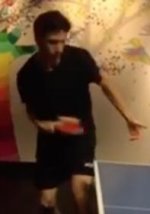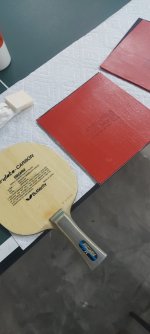Hey, Carl. Not trying to argue, just clarifying what I'm trying to say.
Originally Posted by UpSideDownCarl
Perhaps my method of calculating the time was flawed. But yours seems more flawed to me than mine was. You are trying to calculate the time of her contact by what happens in other shots in the rally which are much faster. Not sure how an average makes much sense.
I agree that an average is not much sense when it comes to that one particular shot. I was simply pointing to a general sense of dwell time in general play.
Originally Posted by UpSideDownCarl
I calculated by the fact that the ball contacts her racket on the one shot in question shortly after the YouTube clock hits 1:40 and ends shortly before the YouTube clock hits 1:41. It could be a little less than half a second. But not much. And it is definitely longer than the 5/100ths of a second you propose. She catches the ball, slowly spins and changes direction with the ball on her racket.
I can't see much point working from the YouTube clock. It's much easier to see what is happening when viewing in .25 speed, then pausing and advancing frame by frame. Here is what I see:
First contact with the ball and next 3 frames:
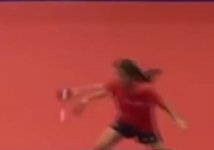
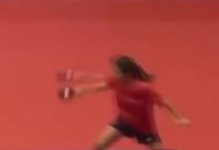
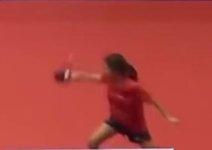
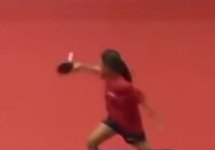
It's clearly visible in the last frame that the ball has already left the bat. These were the frames I did my calculation on, allowing for a maximum contact of four frames. Calculation 1 : 4 frames at 24 fps = 0.16 sec. Calculation 2 (also possible) : 3 frames at 60 fps = 0.05 sec.
What I failed to do was follow the action and record the second period of contact. There are a number of frames where the player's bat is chasing the ball. The last of these is:
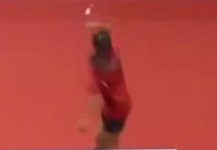
Second contact plus next 3 frames:
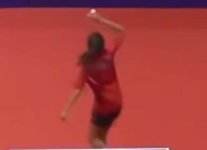
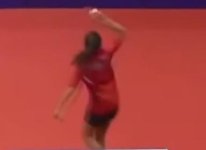
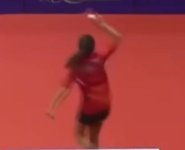
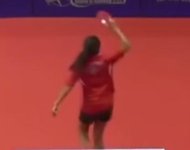
The second last frame is somewhat problematic. Because the ball begins to travel in the direction of the table and the bat is behind it, it's impossible to tell if the ball has already left the bat. Let's give it the benefit of the doubt and the next frame too, even though I think the ball is no longer in contact with the bat. Same calculations as before: If the ball is not bouncing on the rubber, then contact time, i.e. dwell time, is maximum .16 sec.
Originally Posted by UpSideDownCarl
Does it make multiple contacts? Good question and good point. It is possible. But it is also possible that, because she is moving and changes directions while carrying the ball, that it is just one contact. Regardless of whether she catches the ball cleanly or there is more than one hit, she holds the ball on there longer than most.
Sorry, but there's something going on here which is hard to deny. If you look at the first four frames posted and then compare with the last four, you'll notice a strange phenomenon . First four: ball on black rubber. Last four: ball on red rubber. This is the perfect example of the sorts of thing which happen all the time in table tennis arguments: we jump to conclusions without first examining the evidence. And then we offer "evidence" which we think supports our preconceived ideas. Surely it makes more sense to examine the evidence and only then draw a conclusion. The ball hits the black rubber and then hits the red rubber. The ball simply can't be carried on the bat.
Originally Posted by UpSideDownCarl
Now I don't really care about dwell times of a second because it is true that in normal play that does not happen. But it is also true that you can hold the ball on the racket a little longer than the normal 0.5-1 milliseconds...
I would say Mark's serve and that pull ball loop, the contact time is probably about 3 milliseconds. So it is still really short. But a lot longer than a normal dwell time.
But that is demonstrably NOT "a lot longer". At the most - if your estimates are correct - it's
2.5 milliseconds longer. Yes, it's 7 times as long as .5 of a millisecond, but in human measurable terms it's virtually undetectable. It's much more accurate and far less misleading to leave it at "it is still really short".
,
In the end, we're wasting our time arguing about things which are not helpful. Whether it's .05 millisecond or 3 milliseconds, talking about dwell time is distracting us from the one thing which is needful: make the best contact to achieve the result we're looking for. Visualising the ball being dragged across the face of the rubber may be helpful as a tool for making good contact when serving, but... talking about it in terms of dwell time leads us to attempt something which is impossible. There are numerous threads across the tt forums which harp on about which equipment will give the best dwell time. But the only real discussion which is worth having is the one you keep coming back to: it's the skill of the player.






